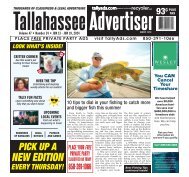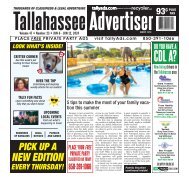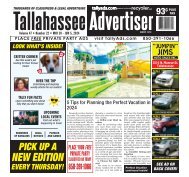Create successful ePaper yourself
Turn your PDF publications into a flip-book with our unique Google optimized e-Paper software.
Safety<br />
Tips<br />
$<br />
A reminder: Plan for your parking just as you<br />
plan for rest of your trip<br />
When it comes to parking, there is no technique or process<br />
that guarantees success in finding a place to park or the<br />
complete safety of driver, vehicle and cargo once a space is<br />
found. There are, however, things you can do to improve the<br />
odds of finding an available space and reducing the risk of<br />
something bad happening while you are there.<br />
The first is to plan for parking just as you plan the rest of<br />
your trip. Waiting until you are tired or nearly out of driving<br />
hours (or both) may work in some parts of the country but in<br />
others it’s a recipe for trouble. Smart drivers plan their parking,<br />
too.<br />
There are many available apps to assist the driver in<br />
finding parking. TruckerPath is an app that not only identifies<br />
fuel stops and other parking locations but allows driver input<br />
providing real time information to the user. Apps like Interstate<br />
Exit Guide, DAT Trucker, Trucker Tools, Park My Truck (NATSO),<br />
TruckSmart (T/A Petro) and Prime Parking (Pilot Flying J) offer<br />
location information as well as fuel pricing and other services.<br />
At some locations, spaces can be reserved for a fee ranging<br />
from $10 to $20 and up.<br />
Some states use signage to inform drivers of available<br />
spaces at upcoming exits, and many states encourage<br />
parking at weigh station lots. Some state DOT websites offer<br />
parking information as well.<br />
When it comes to finding a parking space, timing is<br />
everything. In many areas, truck stop parking lots fill up by 6<br />
p.m. The few spaces that open up as drivers leave are quickly<br />
taken. If it’s possible to adjust your schedule, starting early in<br />
the day provides more time to complete a driving shift and<br />
stop for the night while spaces are still available. Driving at<br />
night can help, too, as it’s easier to find a parking spot at<br />
most truck stops in the morning, when other drivers are just<br />
beginning their day.<br />
Some drivers prefer to find parking on the shoulder of<br />
Interstate entrance ramps or other roadside spots. This can<br />
be a risky practice and some carriers prohibit the practice<br />
with “sitting duck” policies. The risk of accident is higher than<br />
in a sanctioned parking area and secluded areas offer little<br />
protection against criminal activity. Additionally, in the dark,<br />
it can be difficult to judge whether the parking surface can<br />
support the weight of tractor and trailer.<br />
Once parking is found, there are still hazards to deal<br />
with. Remember that the rest period doesn’t begin until<br />
safely parked. Many accidents happen in the short drive<br />
between the Interstate and the parking space as drivers<br />
maneuver through traffic and sometimes confusing driveway<br />
configurations. Driving through a truck stop lot can be like<br />
maneuvering through a maze, especially when some drivers<br />
don’t park correctly.<br />
Truck stops often have a great deal of foot traffic. A<br />
thorough check of a parking space and the surrounding<br />
area is a great idea, before backing into a space. Lighting is<br />
a proven deterrent to crime and a well-lit area is preferable<br />
to a dark one. If you plan to go into the truck stop for a meal,<br />
shopping, or any other reason, think about your route. As<br />
much as possible you’ll want to walk in areas where you, and<br />
anyone who approaches you, can be easily seen. Check all<br />
around your vehicle before getting out, including the mirrors.<br />
While walking, pay attention to your surroundings and<br />
especially anyone who seems to be paying attention to you.<br />
Back in your truck, make sure your doors are locked.<br />
Many drivers employ a cargo rachet strap to further secure<br />
the doors in case locks fail or are deactivated.<br />
Truck stops are often a target of cargo thieves, too. If<br />
you’re pulling a van or refrigerated trailer, it’s a good idea<br />
to back as close as possible to another trailer or any object<br />
that can prevent the opening of trailer doors. Door locks or<br />
other securement devices are never a bad idea. Be aware,<br />
however, that cargo thieves often use truck stops for planning<br />
and information gathering, choosing another location to make<br />
their move. Don’t share information about your cargo or your<br />
destination with anyone and be suspicious of anyone asking<br />
you questions. A common ruse employed by thieves is to<br />
“inform” you of a closed road due to construction or accident,<br />
offering an alternate route that sends you to a secluded area<br />
where the trap is sprung. Always verify any information you<br />
receive from a “friendly” local.<br />
When you leave, be watchful of anyone paying too much<br />
attention to you or following you from the truck stop and call<br />
the police if you suspect you are followed.<br />
Plan for your parking, arrive early enough to get a space,<br />
pay attention to your surroundings and use securement,<br />
for both yourself and your cargo, and your chances of a<br />
safe, comfortable rest period increase. Parking for a wellearned<br />
rest break should be a relaxing time to recharge<br />
and refresh.<br />
16 TRUCKER’S CONNECTION www.Truckers<strong>Connection</strong>.com

















